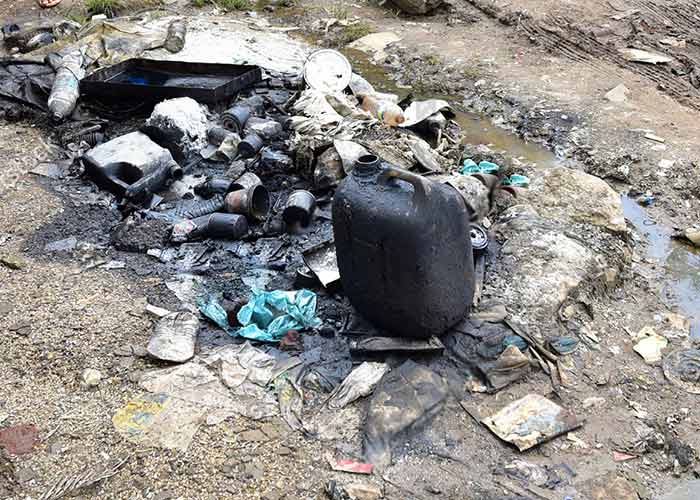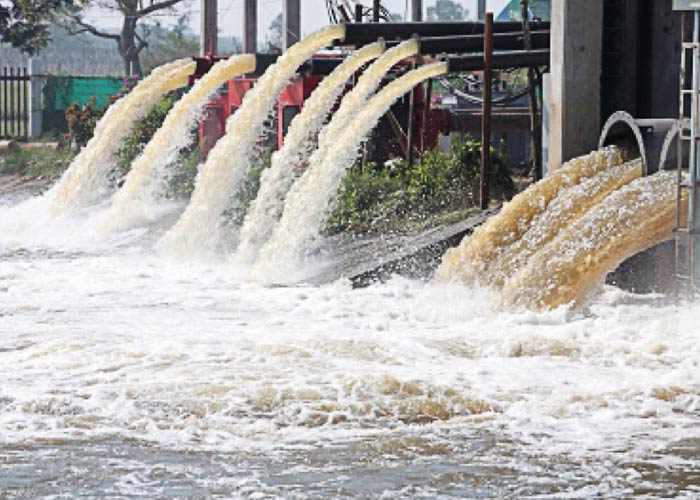Any unwanted change in physical, chemical or biological properties of the soil, which impacts humans and other organisms or the soil’s natural quality such as fertility and utility, is called soil pollution. Various factors are considered to be responsible for soil pollution. According to scientists, soil pollution is identified as the damages done to the top soil of the land. Soil pollution is synonymous with the problem of disposal of solid waste. From a large perspective, it includes changes in the soil’s basic properties as a result of and human and natural processes – soil degradation, chemical pollution from various sources, geological excavations, and volcanic eruptions.
Soil is the basic unit of environment and we cannot even imagine life without the existence of good and fertile soil. Large scale industrialization and urbanization, the increasing population in the cities and the emerging fluid and solid residues are polluting the soil. Their stacks take the form of dunes and spread far and wide. These soil polluting materials include solid waste like ash, glass, fruits and vegetables, papers, clothes, plastics, rubber, leather, metals, etc.
Main Causes of Soil Pollution (Land Pollution)
There are two causes: man-made or human (anthropogenic) causes and natural causes.
Human (Anthropogenic) Causes of Soil Pollution
Human-caused soil pollution can work with natural processes to increase the level of pollution in the soil. Following are some human-caused reasons of soil pollution:
Solid Waste
Soil pollution is caused due to various household wastes and chemical fertilizers used in farming, besides chemicals and wastes generated in the industries. Most of these wastes contain residues of toxic inorganic and organic chemicals, which are extremely harmful. In these residues, radioactive elements such as strontium, cadmium, uranium, ladders are also found, which affect the vitality and fertility of the land.
Fly ash is another major source of pollution surrounding the industrial area and it gradually gets mixed into the soil. Many other wastes which do not have biological degradation such as polythene bags, plastics etc also pollute the soil by affecting physical structure of soil.
Flawed Agricultural practices:
Soil pollution takes place due to fertilizers, insecticides and pesticides used in the fields. Often, chemical fertilizers like lead, mercury and arsenic containing organic compounds are used in the crops. They contaminate the soil by changing their physical and chemical properties. As a result of such kind of pollution in the soil, the growth of crops and plants decreases.
In commercial agriculture to get maximum yield, weed-killers and insecticides etc. are being widely used. Use of inorganic chemical fertilizers is also increasing day by day. Chemicals such as phosphate and nitrogen are polluting the environment, groundwater resources and the soil. The most dangerous pollutants in this category are bioactive chemicals, due to which the micro-organisms of soil are being destroyed, resulting in decreased quality of soil. The chemical pollutants gradually enter the diet chain through the crops produced. These chemical pollutants or bioactive chemicals are also called Creeping Deaths. In the last 30 years, the use of organic chemicals has increased by more than 11 times. India alone is using 100,000 tonnes of bio-chemicals per annum and thus the soil is getting increasingly polluted.
In a study conducted in Uttarakhand in January 2011, it came to light that wheat and rice crops are proving to be harmful for soil health in this state. It is because the consumption of urea manure has increased there by two and a half times in a year. Earlier, on an average, four bags of urea were used in fields of the state, now 10 bags are being used and thus it present a scary scenario. For the balanced use of these chemicals in farming, the ratio of nitrogenous phosphorus and potash should be 4: 2: 1, but this is not happening due to the compulsion to maintain productivity.
Recently, a tendency has been noticed in the farmers that they have decreased the use of potassium and phosphorus as fertilisers in soil and have increased the use of urea to gain high productivity without caring for its ill effects on soil. Urea is an extremely harmful chemical fertiliser for soil and its increased use pollutes the soil while making it unfertile in the long run. Deforestation of the upper surface of the soil in mountainous districts is increasing rapidly which compels the farmers to increase the use of urea. Due to this, soil health is deteriorating further. The unbridled use of manure, coupled with the use of pesticides ultimately harms human health.
Also, to prevent plants and animals from getting infected from various germs chemicals such Mailathian, Gamaxin, Dithane M-45, Dithane Z-78 and 2,4-D, etc are sprinkled which are extremely harmful substances.
After harvesting of crops, the remaining leaves, stalks, grasses, seeds etc, generally, do not lead to any serious pollution because these residues of plants are mixed in soil and are automatically decomposed by biological functions. The problem arises when their unnecessary pile is dumped on the fields and this organic debris starts to decay by rain water.
Domestic Waste:
Soil pollution is increasing due to increased amount of domestic waste. Household waste includes food scraps, old newspapers, and plastic items, bottles, wood, glasses, cans, old tools, tyres, worn out furniture, broken toys and many other substances.
The domestic wastage mainly includes dry wastes and wet leftovers of kitchens. Dry waste includes dust as a result of cleaning, waste paper, cardboard, wooden leaves, broken pots of glass or porcelain, vials, tin containers, hearth-ash, pieces of clothing etc. Apart from these, some big items such as broken furniture, impaired motor vehicles equipment, redundant components, tyres etc, can also be included in this. Substances derived from the kitchen include vegetables, peels of fruits-pulses, rotten fruit, vegetable stalks, fruit kernels, tea leaves, egg shells, and leftover after eating.
Per capita quantities of domestic waste depend on economic status and social development. Thus, its average varies in different countries. For example, in the US, domestic wastage is 50 kg/person /day. The amount of solid waste generated by our urban population (about 20 crore) in the country is estimated to be 5crore tonnes per annum. Accordingly, large quantities of solid waste are generated throughout the country as the country’s population is almost five times the urban population.
Every day while cleaning kitchen remnants, plastic pieces, pieces of cloth, glass, vials, thermocol, aluminium, iron wire, tin container, tyres and other waste are removed from the homes and thrown as garbage. This garbage ultimately reaches the soil and pollutes it.
Municipal Waste:
Under the municipality, the entire city’s garbage can be found which leads to contamination of the soil. Dumping of domestic and municipal waste in cities is a serious problem. Diseases in humans such as dysentery, diarrhoea, plague, malaria and many other diseases are the result of indiscriminate dumping of waste.
Municipal waste includes garbage removed from homes; human excreta, waste of fruits and vegetables thrown in markets, waste of various industrial organizations, plant waste of gardens, dung mixed with fodder of animal shelters, garbage and sludge from street drains and gutters, and all kinds of litter generated from slaughter houses, butcher’s shop, fish market, poultry centres and leather research institutions.
Industrial Waste:
Unused chemicals and unwanted industrial waste such as lead, copper, fly ash, mud, plastic and sawdust are some unused chemicals which inhibit the growth of organic agents in the soil.
In highly industrialized countries, domestic and municipal wastes comprise a fraction of total waste. The main waste there consists of industrial waste. Some of these wastes are bio-degradable, some flammable, toxic, some foul-smelling and some are inactive, but all of them occupy space and become the cause of soil pollution in some form or the other. The problem of deposition of industrial waste becomes more complex due to economic limitations. It is less expensive and more convenient to throw industrial waste on the available land or dump them by digging pits without treatment for industry managers. This is the reason why the pile of garbage is increasing everywhere on the available land around the industrial areas.
Chemical Waste
There are many types of chemical substances in the waste dumped by the industry on the ground. Many times many chemical substances get merged in the soil, accidentally or unconsciously. These pollutants are found in water of domestic drains, flowing or underground water. Due to the irrigation of fields or vegetable gardens with this water, there is great harm to fruits, vegetables, and various types of food and pulses.
Biological Agents
Biological agents such as bacteria, fungus, viruses, and protozoa are a major source of soil pollution and these are mostly spread through the discharge of human and animal waste which is a major source of soil pollution.
Radioactive Pollutants
Radioactive pollutants are generated from explosive devices, atomic tests and atomic activities in laboratories of nuclear power plants. Radiation -106 and Rhodium -106, Iodine-131, Barium-40, Lanthan-40, Serium-144, etc, reach the radioactive waste and mud produced by nuclear testing laboratories. All of these radionuclides emit gamma radiations, which are also harmful to the soil.
Mining and smelting:
Mining and smelting activities by coal and mineral mining industry is a major cause of soil pollution. Extraction and processing of mineral ores weakens the surface of the soil. Moreover, establishment of cement factories in the hilly areas and dust of cement which fall on the soil, prevent the growth of flora and natural vegetation.
Construction Activities
Small particles of the dust during construction activities can easily spread all through the air and slowly intermingle into the soil. It causes various respiratory diseases including asthma, bronchitis and even cancer. Demolition of old buildings also causes soil pollution because it releases asbestos (a toxic mineral) that acts as a poison in the soil.
Acid rain
Acid rain damages the basic properties of the soil. The polluted soil becomes acidic in nature. It has a negative effect on plants and animals.
Industrial units such as fertilizers, chemicals, sugar factories, garment making units, graphite, thermal power plants, cement factories, soap, harmful and toxic chemicals in bulk by oil and metal fabrication factories are mostly spreading soil pollution. Residues of all these materials produce gases such as sulphur and nitrogen oxide. When combined with atmospheric water, these gases form acids and pollute the soil in the form of acid rain.
Soil Erosion
The natural structure of the soil changes with soil erosion and the useful land is destroyed. The process of erosion of soil takes place due to the coordinated forces of gravity, air, water etc. In other words, soil erosion is a process by which the soil particles transfer from place to place due to the effect of external factors (air or flowing water). Thus, the upper portion of the land is inadvertently destroyed.
Soil erosion is a very slow process in nature, but its results are far-reaching and widespread. Deserts, infertile large agricultural lands, hilly areas devoid of vegetation are the result of soil erosion. Humans have an unusually big hand in increasing the speed of naturally occurring erosion. Excessive farming, destruction of forests, excessive grazing by animals too increase soil erosion. For all these reasons, the productivity becomes low and the vegetation cover is reduced. Soil erosion is hastened by the absence of root systems as a result of lack of plants that keep the soil intact.
Natural Causes of Soil Pollution
Natural factors due to which soil degradation occurs include volcanic eruptions, alterations in rainfall patterns, earthquakes, geographical changes, air pollution and melting of glaciers.
At times, natural accumulation of chemicals results in soil pollution while sometimes natural processes also raise pollutant toxicity and soil pollution level. Soil has complex properties that can contain both chemicals and natural conditions that can interact with one another to produce pollution. Following are some natural processes that cause soil pollution:
- Due to the imbalance between the atmospheric deposition and leakage with rain water, the natural accumulation of compounds takes place in the soil (accumulation of perchlorate in dry environment)
- Natural production of perchlorate takes place in the soil in some environmental conditions (in the presence of metal objects and energy generated by the storm).
- It is also caused due to sewer lines leakage in the subsurface of soil.
Conclusion:
Among the available land on the earth, only approximately 50 percent of the land surface is suitable for the use by humans and the animals and the remaining 50 percent of it comprises mountains, trenches, swamps, desert and plateau etc. It is also important to note that 79 percent of the world’s food items are produced from the soil. The importance of soil increases even more when we already know that only two percent of the globe has agricultural land.
So, the soil can be categorised as an extremely rare (very limited) resource. The speed at which the population of the world is increasing today, soil is being exploited beyond limits to arrange for food. In order to increase productivity, humans have been using chemical fertilizers and pesticides. As a result, today the nutrient capacity of soil is decreasing at alarming levels. Today, there is an urgent need to save this limited resource from pollution to ensure adequate availability of habitats and food items.
More on Soil Pollution







